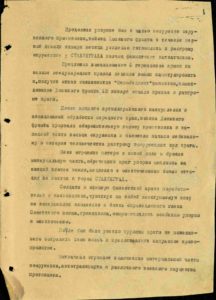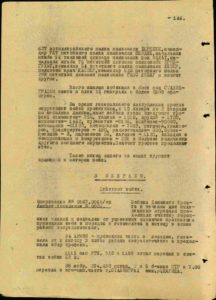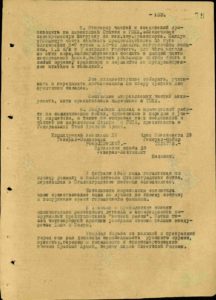The Battle of Stalingrad mini-exhibition published on the 80th anniversary tried to maintain a human angle on the monumental stand-off. Only the human Toll video makes a mention of the numbers. This article is somewhat different in this regard. Here we will take a look at a few pages from the “Journal of combat operations of the Front troops” pertaining to the Battle of Stalingrad.
Such journals were logged in accordance with the military regulations and recorded which units and troops performed which tasks on any particular day; where the units were moved; which losses they suffered; what victory trophies they gained. The journals would sometimes include copies of relevant orders and documents.
All materials from WWII were declassified by Russia several years ago and can be found on the site of People’s Memory. The journal that interests us holds the records from the 1st of January to the 5th of February 1943, over a span of 310 pages. It was logged by the Don Front, and is now archived in Fund 206, File 262, Case 189.
Even such a dry document, logged by scribes, contains glimpses into the emotions and the contemporary realisation of the historical significance of the unfolding event. Let us first take a look at the preface – the very first pages of the journal.
Each page can be enlarged by clicking on it.
And now to the culmination, told over the course of 4 pages, starting with page 143:
The Headquarters of the Don Front, February 2, 43, 18.30
Moscow.
To the Supreme Commander-in-Chief of the Armed forces of the USSR, comrade Stalin
Combat Report No. 0079/op.
Following Your order, the troops of the Don Front at 16.00 on 2.2.43 completed the rout and destruction of the encircled Stalingrad enemy group.
Completely destroyed and partially captured: 11th army corps, 8th army corps, 14th tank corps, 51st army corps, 4th army corps, 48th tank corps consisting of 22 divisions: 44,71,76,79,94,100 light,113, 376, 295, 297, 305, 371, 384, 389 infantry divisions ; 3, 29 and 60 motorised divisions; 14, 16 and 24 panzer German divisions ; 1st cavalry and 20th infantry Romanian divisions
In addition, parts of the reinforcement have been destroyed:
a/ 42,44,46,59,61,65,72 artillery regiments of the RGK, 1/97 ap 43,639,733,856,855,861 artillery divisions of the RGK; 243rd division of assault guns; 2nd and 51st mortar regiments of the RGK with the 6-barrel mortars; 9,12,25,30,37,91 anti-aircraft divisions of different regiments, some parts of which operate on other fronts.
b/ 45,71, 294, 336,652,685, 672,501 separate sapper battalions and one separate sapper battalion without a number.
c/ 21,40,540,539 separate construction battalions.
d/ 6th communications regiment and presumably 594th communications regiment.
e/ 7th and 28th divisions of artillery instrumental reconnaissance /AIR/.
f/ Many bridge columns and other service parts.
More than 31,000 prisoners were captured, including more than 2,500 officers and 24 generals, including: Field Marshal 1, general-colonels 2, individual lieutenant generals and major generals.
In connection with the complete liquidation of the encircled enemy troops, the fighting in the city of Stalingrad and in the Stalingrad area has stopped.
The trophy counting continues.
|
The representative of the Headquarters of the Supreme High Command, Marshal of artillery
Voronov.- |
Commander of the trops of the Don Front, Colonel-General
ROKOSSOVSKY.- |
|
Member of the military council of the Don Front, General-Major
Telegin.- |
Chief of Staff of the Don Front, Lieutenant-General
Malinin.- |
– – – – – – – – – – – – – – –
Order
Of The Supreme Commander-in-chief for the troops of the Don
Front.
Don Front
To the Representative of the Headquarters of the Supreme High Command, Marshal of Artillery, comrade Voronov
To the Commander of the troops of the Don Front, Colonel-General, Rokossovsky.
I congratulate You and the troops of the Don Front on the successful completion of the liquidation of the enemy troops encircled at STALINGRAD.
I declare my gratitude to all the fighters, commanders and political workers of the Don Front for excellent combat operations.
Supreme Commander-in-Chief
I. Stalin.-
Moscow, Kremlin, February 2
1943.
– – – – – – – – – – – – – –
Today, on February 2, the troops of the Don Front have fully completed the liquidation of the German-Nazi troops encircled in the Stalingrad area. Our troops broke the resistance of the enemy encircled north of STALINGRAD and forced it to lay down its arms. The last centre of enemy resistance in the STALINGRAD area has been crushed. On February 2, 1943, the historic battle of STALINGRAD ended with the complete victory of our troops.
Over the past 2 days, the number of prisoners has increased by 45,000, and during the fighting from January 10 to February 2, our troops captured 91,000 German soldiers and officers.
On February 2, our troops captured the commander of the 11th Army Corps, commanding a group of the German troops surrounded north of STALINGRAD, Colonel-General STRECKER and his chief of staff, Colonel of the General Staff HELMUT ROSSKURT.
In addition, on February 1 and 2, the following generals of the German army were captured: 1/ commander of the 8th army
Colonel-General WALTER GEITZ, 2/ Commander of the 76th Infantry Division, Lieutenant-General von RODENBURG, 3/ Commander of the 113th Infantry Division, Lieutenant-General von SIXT ARMIN, 4/ commander of the 24th Panzer Division, Lieutenant-General von LENSKI, 5/ commander of the 389th Infantry Division, Major-General MARTIN LATTMANN, 6/ Commander a group of the German troops surrounded west of the central part of STALINGRAD, Major General RASKE, 7/ Major General MAGNOS.
The personal adjutant of Field Marshal PAULUS, Colonel ADAM, commander of the 14th tank Division, Colonel LUDWIG, commander of the 227 Infantry Regiment of the 100th Infantry Division, Colonel FRANZ NEBEKKER, commander of the 2nd mortar regiment, Colonel FRIEDRICH NAYER, commander of the 29th artillery regiment of the 29th Motorized Division, Colonel GMPTER KRAG, Chief of Staff of the 8th Army Corps, Colonel SCHNITZER, chief of artillery of the 1st Romanian cavalry division Colonel MALTOPOL, commander of the 13th sapper regiment of the 8th Army Corps Colonel SCHILLENG, Chief of Staff of the 76th Infantry regiment Colonel BELOGULAT, Commander of the 48th separate communications regiment, Colonel KARENETSKY, commander of the 51st artillery regiment 376 infantry division Colonel SCHWARTZ, commander of the 134 infantry regiment of the 44 infantry division Colonel BOYE, commander of the 376 artillery regiment Colonel FUHR, commander of the 576 infantry regiment of the 376 infantry division Colonel SCHITESENF, commander of the 37 artillery regiment Colonel VOLT, commander of the 134 artillery regiment of the 44 infantry division Colonel BOSARTHUR, commander of the 536 infantry regiment of the 376 infantry division Colonel SCHLESINGER, commander 627 artillery regiment Colonel BERENEK, commander of the 767 infantry regiment Colonel SCHEIDLE Chief of staff of the 14th Panzer Division Colonel von VOLT, Colonel BRIDGULT, Chief of Staff of the 76th Infantry Division, Colonel LEBER, commander of the 54th Infantry Regiment, KAISER, regimental doctor, Colonel HANS LIEBAU, commander of the 523rd infantry regiment of the 297th Infantry Division, and many others.
In total, our troops captured 24 generals and more than 2,500 officers in the battles near STALINGRAD.
During the general offensive against the encircled enemy troops, from January 10 to February 2, according to incomplete data, our troops took the following trophies: aircraft – 750, tanks – 1550, large calibre guns – 6700, mortars – 1462, machine guns – 8135, rifles – 90,000, cars – 61102, motorcycles – 7369, trucks, tractors, transporters – 480, radio stations – 320, armoured trains – 3, steam locomotives 56, railway wagons – 1125, ammunition and armament depots – 285 and a large number of other military equipment. The accounting of the trophies continues.
Such is the outcome of one of the largest battles in the history of wars.
Then comes the 3rd of February, and the regular journaling of the actions of various units, though one entry stands apart:
During the day, the troops of the Don Front continued to clear city buildings and basements of the surviving lone enemy units, cleaned themselves up and prepared to enter new areas of concentration.
64th ARMY – put the units in order, prepared them for transfer to new areas of concentration and continued collecting trophies.
There were still 2 long year ahead until the Soviet troops would enter Berlin, thus putting a… no, not a full-stop, but, rather, a semicolon in the fight against the Nazism.
And the entries in the journal reflect this urgency, and the need to keep the army organised – there was no time for celebration and for personal trophies. Besides, if the individual soldiers start focusing on trophy collection, that alone would corrupt a well-organised army. This is underscored on page 153 in two terse paragraphs.
5. Dispatch of divisions and units should be carried out according to the directives of the HQ and the General Staff of the Red Army (GSHKA), ensuring timely loading on railway transport. Each departing division should be supplied with food for the route of 5-7 days and a 10-day unloading stock, 1.5 ammo load-out and 2 refuellings, for which, based on these norms, an irreducible stock must be created in each division in advance. Prohibit the departing units from taking with them weapons, transport and property not provided for by the regulations and tables.
All the excess should be confiscated, accounted and transferred to the trophy collecting organizations or frontline warehouses.
The condition of the sent units must be noted down, and the acts are to be presented to the General Staff of the Red Army.
However, pages 153 and 154 still contain the words of celebration, formulated in reservedly-exuberant military style, spoken by Major General Boikov, who was the deputy of the Chief of Staff of the Don Front, General-Lieutenant Malinin. The document was typed by the scribe, Major Masjuk, and it could well have been his personal initiative to include Major General’s words, so uncharacteristic for a “Journal of combat operations”, thus literally writing the conclusion to the Battle into the pages of History.
On February 2, 1943, the Battle of Stalingrad, gigantic in its scope and consequences, turning into the Stalingrad massacre, has ended.
The army of German Fascism, one of the best armies in its composition and armament, ended its existence in an ignominious defeat.
In the Don and Volga steppes, the legend of the invincibility of the armed representatives of the “higher race” has been finally debunked. Hundreds of thousands of pure-blooded Aryans fertilized the interfluve of the Don and Volga with their bodies.
The stubborn struggle for the great and beautiful city has once again proved the invincibility of the Russian weapons, courage, heroism and readiness for self-sacrifice of the soldiers of the Red Army, loyal sons of the Soviet Motherland.
Having fulfilled the order of the leader comrade STALIN, having withstood the frenzied pressure of the select German troops, having stopped them, surrounded and destroyed them, the troops of the Don Front began to prepare for the fulfilment of the next tasks in the struggle for the liberation of their Socialist Motherland.
Deputy chief of staff of the don front chief of operations Major General
Boikov.-








